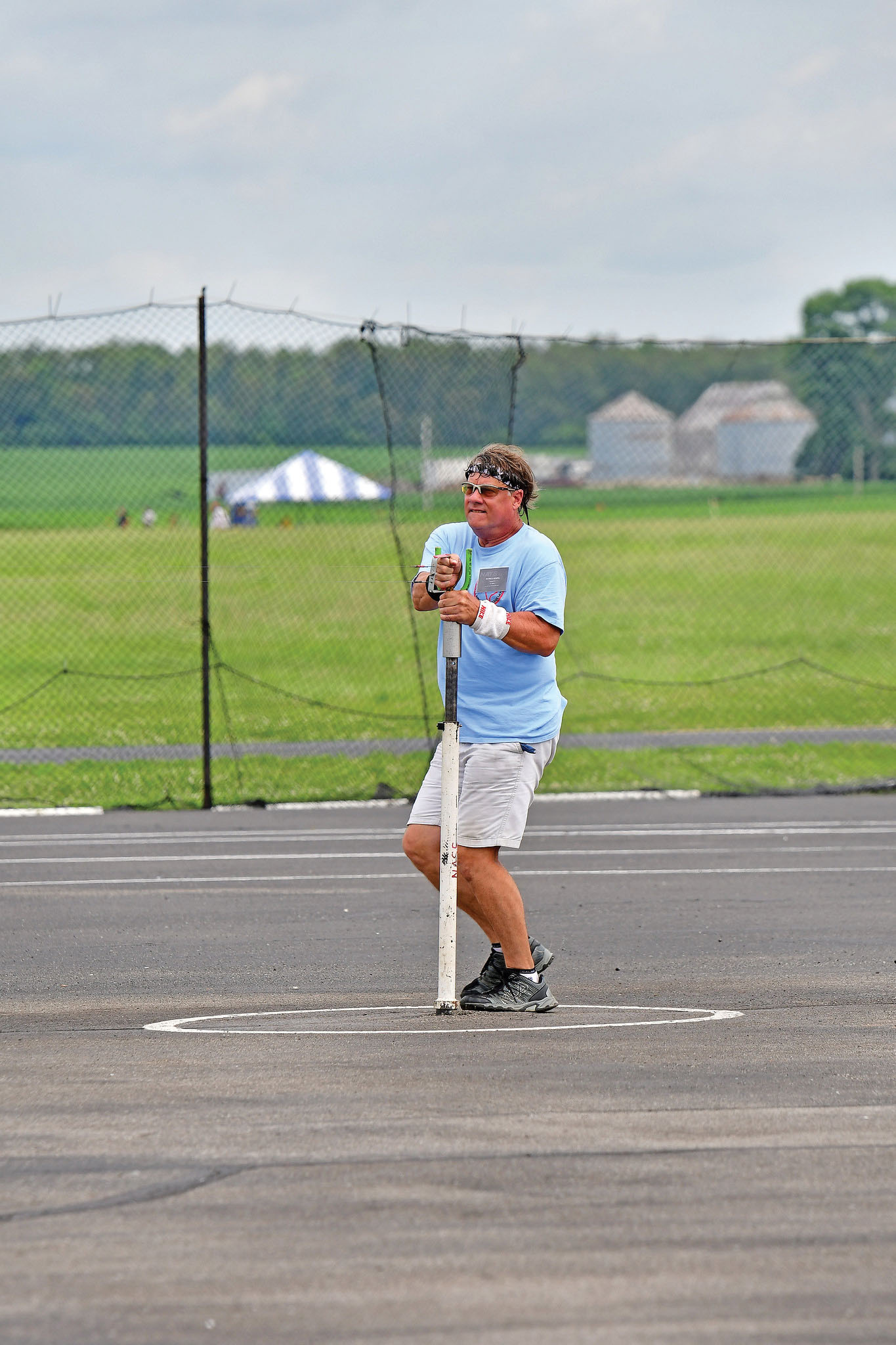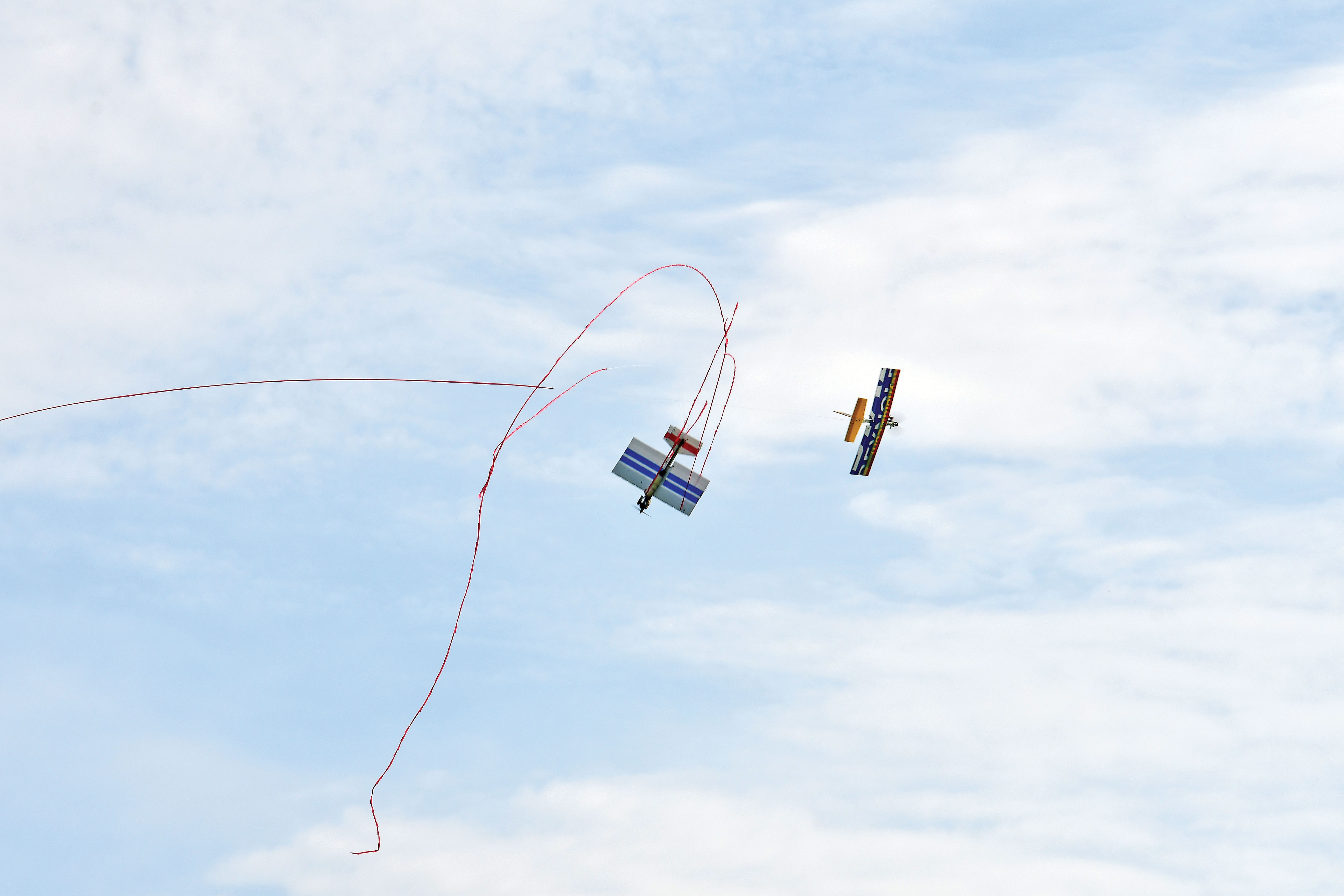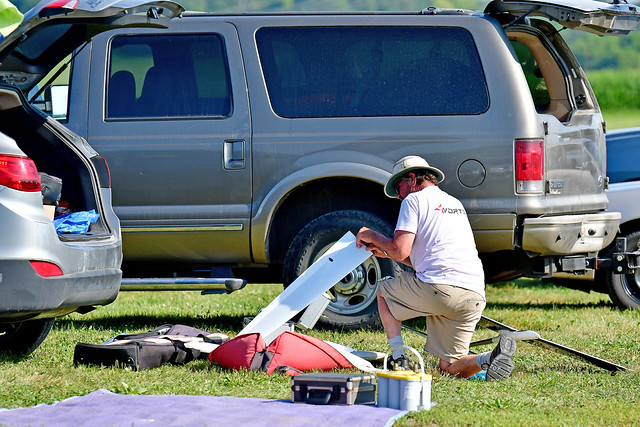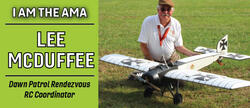Written by various authors as noted
NatsNews extended
As seen in the November 2019 issue of Model Aviation.
Nats Demystified Playlist
Image

Image

Image

Indoor FF May 30-June 2 Springerville, Arizona
By Rob Romash The Round Valley Dome in Springerville, Arizona, sounded great on paper, but it presented some pros and cons. On the positive side, it’s almost impossible to get a rubber-powered model hung up on the ceiling because there is nothing to get hung up on—you just bounce. The con side is that this is one of the only indoor high-ceiling sites with consistent lift and sink to be taken advantage of or it can knock you out of the air. At a 7,000-foot altitude, you have 1/4 less air density to fly with. This year, the first-day annual tradition of starting out with glider events held true. Throughout the building, one could hear the "buzz" of high-speed gliders ballistically shooting at the ceiling and the occasional crunch as something went terribly wrong.Image

Image

RC Scale Aerobatics July 7-10
By Rich Whitlow Everyone converged on the AMA’s International Aeromodeling Center in Muncie, Indiana, on Saturday after the July Fourth holiday. There was plenty of practice flying and preparation. Everyone was putting last-minute touches on his or her flights before the start of the competition on Sunday. Sunday morning started slow, with fog keeping the ceiling low. But when the competition started, it was full speed ahead with lots of opportunities for a full day of flying. There were some great flights, some successes, and some struggles. We had a couple of dead-stick landings and a complete DA-200 engine changeout that was successfully done between rounds.Image

Image

Image

Nats 2019: RC Scale Aerobatics (IMAC) Album

CL Scale July 12-14
By Fred Cronenwett The most notable change in Scale competition this year was that RC Scale took place on the same days. The only time that the Control Line (CL) and RC Scale models were together, however, was during the static judging on Friday, July 12. CL Scale had a wide variety of events being flown—from small models with 1/2A-size engines (.061 or smaller) to larger Sport Scale models. The ages of the competitors greatly varied this year, with pilots of all ages flying together. There were eight entries in 1/2A Scale, including Junior competitor Christopher DeGroff, who brought his new Brodak F4F Wildcat to fly in 1/2A Scale. This is the young man who flew his Brodak P-51 the last two years in 1/2A Scale. Fun Scale is another popular event because people can fly older, retired models, purchased models, or ARFs. With only 10 static points, this event really comes down to the flying score to win. The other events flown this year were Profile, Sport, Authentic, and Team Scale. Authentic Scale replaced the older Precision Scale. A variety of models competed—everything from civilian aircraft such as the slow Cub, to heavy bombers and multiengines. Ed Mason, a Nats regular, brought out his new electric-powered DC-3 with flaps. Allen Goff had his new Nieuport 17 biplane in Sport Scale, and Jeff Jensen had a new Piper Arrow for Profile Scale. Saturday evening, we had the National Association of Scale Aeromodelers (NASA) Banquet to present the High Static awards and induct new people into the Control Line Scale Hall of Fame. Ralph Burnstine, along with Joe Coles (deceased), Ed Mason, Chuck Snyder, and Fred Cronenwett were inducted into the CL Scale Hall of Fame. The RC Scale group started its own hall of fame this year. The special guest of the evening was Hazel Sig, who formerly operated Sig Manufacturing. She was inducted into the CL and RC Scale halls of fame. After she received her award, she told the attendees how she drove her Corvette at high speeds and shared stories of flying full-scale aircraft. The contributions that Sig Manufacturing has made to Scale modeling are extensive and were publicly recognized by honoring Hazel.Nats 2019: CL Scale Album

RC Scale July 12-14
By Stan Alexander Some of the more interesting models here this year included a Top RC Fw-190 A6 version with a 92-inch wingspan and a custom paint job, swinging a 24 × 10 propeller on a DA-70 engine. It belonged to Sonny Coleman of Texas. There were several contestants from Texas this year, including Lawrence Harville, AMA District VIII vice president. Many of those from Texas, Tennessee, and Alabama pitted next to each other this year and had fun.Image

Image

Image

RC Pylon Racing July 13-20
By Santiago Panzardi, Dan Kane, and Tim Sparks The first event of the 2019 RC Pylon Racing Nats was Club 40. The contest started with two-pole racing, which is a nice change from the hectic pace of the AMA three-pole events. Two classes were raced, Silver and Bronze, with 16 total entries. Gary Fisher was named the Silver class champion and David Poland continued his reign in the Bronze class. Brad Clayton was the Silver fast-time winner at 1:28.82. Our youngest competitor was the Bronze fast-time winner, Clay Williams, at 1:45.0. In Super Sport Q-500, the finals consisted of 28 qualifiers flying in five rounds. A racehorse start was used instead of the normal 1-3, 2-4 starting sequence. This caused some mishaps on takeoff. In the end, Mike Helsel dropped a point in the refly and Jim Allen won. Mike saw victory slip through his fingers in Q-500, but he grabbed it by the horns in Electric Formula 1! This unique event departs from the fire-breathing, nitro-eating, two-stroke engines that normally dominate the Pylon events. The class was started a few years ago to bring back some history. The airplanes must be recognizable replicas of full-scale Formula 1 or Goodyear racers. This year there were 34 entries. Sport Quickie (AMA 424) is the entry-level Q-500 class. The rules only allow non-composite wing aircraft. It was great to see Jordan Peace and Brian Osman make the journey to the Nats and compete in the three-pole event. Some of the highlights include seeing Scotty and Maureen Smithwick turn in the fastest time for the event. Super Sport Q-500 is spec class racing with only one approved engine, a Dub Jett Super Sport Quickee. There are many airplanes available for this class. Using a single matrix for the qualifying rounds this year allowed for some decent time between heats. Pilots weren’t rushed to prepare their models for the next heat. This was a positive and welcome change. Approximately 50 contestants entered Q-40 this year. The first two rounds were unrelenting, with most pilots posting times between 1:03 and 1:08 (with the exception of Roy Andrassy, who proceeded to smoke the course with almost 1 minute flat for 10 laps). Many airplanes were lost in the first two rounds, sidelining a few top pilots including multitime Nats Champion Dub Jett. After two tiebreakers, the winners were announced: Bryan Blanchard third, Roy Andrassy second and fast time, and for the first time, the winner of the AMA Q-40 Nats was Terry Frazer. During the National Miniature Pylon Racing Association’s (NMPRA) annual banquet, James Gager and Dan Kane were inducted into the NMPRA Hall of Fame. A third person will be inducted later.Image

Image

Nats 2019: RC Pylon Racing Album

CL Precision Aerobatics July 14-20
By Matt Neumann This year we had an upswing from last year in attendance. The Advanced class had 30 contestants, while the Open class had 41, totaling 71 contestants overall. Not a bad turnout. This year’s Concourse winner was Jim Aron. He has a wonderful orange and black airplane that has some very intricate designs. Wednesday marked the first day of official flights. The Open and Advanced groups were split into four separate groups. Each group flew two flights in front of two sets of judges—one set of judges Wednesday and a different set on Thursday. The best flights from each day were totaled to see who made the cut to fly on Friday. The top five from each group in the Open skill class and the top four from the Advanced class moved on to Friday’s flying. The scoring Friday was quite close for the most part. We had a few high scores, but not many. Most were within a 20-point range—in the 530s and 540s. It was a real shootout.Image

Nats 2019: CL Stunt Album

CL Speed July 15-19
By Rachelle Haughn Team USA F2A 2020 was selected at this year’s Nats. The contest to determine who would compete next year in Wloclawek, Poland, took place on the second day of CL Speed. After the dust settled, William "Bill" Hughes finished first, Alexander "Alex" Valishev was second, and Patrick Hempel finished in third to round out Team USA F2A. Ivan Valishev will be the Junior team member. Alex, Bill, and Ivan previously competed in the 2018 FAI F2A Control Line World Championships in Landres, France, where Ivan finished first in the Junior category. The FAI F2 World Championships for Control Line Model Aircraft is set to take place August 9-15, 2020. The most popular contest at this year’s CL Speed Nats was 1/2A Profile Proto, with 10 entries. These screaming-fast airplanes are flown on 42-foot lines. Joey Mathison went home with the victory in that class, followed by James Van Sant in second, and Glen Van Sant, James’ father, in third. Other contests flown throughout the Nats included A Speed, B Speed, D Speed 1/2A Speed, and Formula 40. Nats regular Chris Montagino took the victory in A Speed, 1/2A Speed, and Formula 40. Glen took first in B Speed, and Bill topped the D Speed contest.Nats 2019: CL Speed Album

CL Racing July 15-18
By Tim Stone This year’s racing schedule was tighter and had consolidated events to reflect a declining interest in CL Racing. The first day of the competition included Team Racing, F2C, and AMA Mouse Racing. In F2C, a rule change required an exhaust cover to be added. Dick Lambert and Tom Fluker came well prepared with outstanding fabrication on their entry. Five teams competed. In 3-up, round one ended in a midair line entanglement and crash between two teams that destroyed one of the aircraft. Mouse 1 had a healthy turnout of 11 teams, including first-time Nats Junior entry Sam Londke. Also new to the racing circles were brothers Mick and Mark Warning, with assistant George Reynolds. Former racer Dave Decker stepped in and flew David Betz’s entry. Two events were run on Tuesday, July 16: Slow Rat and Goodyear. Slow Rat has run with the maximum .25 engine size for a few years. The powerful .36 engines that were previously used were hard to find and heavy. Five teams entered this year, including newcomers Mick and Mark. Bob Oge had an outstanding heat run. He and Mike Greb went to the finals. Mike Greb had some pitting troubles, and Bob coasted to an easy win. Goodyear has had a decline in entries because of the shortage of .15-size engines. This year, there were four entries. By race time, the wind had picked up, and only Mike posted a heat time. There was no final because the event was rained out. In Super Slow Rat and Texas Quickie Rat, there were eight teams. Bill Bischoff/Mike Greb won with an excellent time of 5:24. The competition wrapped up Thursday with Clown Race and Sport Goodyear. Clown Race rules specify that only a PDQ Clown aircraft can be flown. Unlike other racing events, the winner is determined by who flies the most laps in a specified time period. There were four entries this year, and lap counts for all teams were between 136 and 138. Sport Goodyear has become more popular throughout the years. There were 11 entries in this hotly contested event. Racers were given two 80-lap preliminaries with two 3-up finals runs.Nats 2019: CL Racing Album

CL Combat July 15-20
By Phil Cartier The first day of the 2019 F2D Team Trials had plenty of interesting incidents. A total of 28 fliers registered and flew. It’s not a record number, but a good turnout, nonetheless. Roughly half of the matches had intense, close-quarter flying. There were not many cuts because the pilots were so good at evading them. Day 2 of the team trials started midway through round 5, which quickly cut the field to 15. Bill Maywald and Chuck Rudner had just one loss. Round 6 reduced the field to 10. The final round determined the three pilots for the team and three alternates. Team USA F2D 2020 members are: Radik Magzianov, Chuck Rudner, Mark Rudner, Sasha Nadein (Junior), Rylan Ritch (returning Junior World Champion), first alternate Jeff Johnson, and second alternate Aimee Olson. F2D Fast is a favorite with some F2 fliers, and any F2D airplane from 2010 is allowed. There were 20 entries this year. It requires instant reflexes, lots of practice, and excellent pit work. Speed Limit Combat keeps the speeds below 75 mph. A total of 21 fliers competed, including some who generally don’t travel extensively. This year there was a new rule for enforcing the speed limit. Instead of a speed without a streamer, it specifies a speed with the streamer. The 1/2A Combat contest is a bit like swatting mosquitoes. The airplanes are small, have tight turning, and are difficult to see. The aircraft are scaled down and look like Fast Combat models. Eighteen pilots squared off for a double-elimination, first-round contest on July 19. Fast Combat has grown slowly in the last few years. This year there were 10 competitors. The Fast Combat rules are simple. Basically, pilots must fly fast, cut the string (kill), and win. The match for first and second places was between Mike Evans and Jeff Rein. Mike got a clean start. Jeff had to flip. They got separated and the judge signaled Combat. They did roughly two Figure Eights and on the backside of the second one, Mike got lined up, turned behind Jeff, and got a clean kill. In the third and fourth match, Ed Bryzs and Neil Simpson squared off. During the final bracket, Neil fought to keep his airplane under control while Ron Colombo tried to untangle the lines. Neil ended up going down too. They both got back up, with Neil winning based on his airtime.Image

Image

Image

Nats 2019: CL Combat Album

CL Navy Carrier July 16-18
By Dick Perry Some of the regulars sat it out this year because of conflicts and injuries, but there were a few new faces and some returning veterans from previous years. There were also some new aircraft this year, and the percentage of MO-1 models was down. The contest began with Profile Carrier on Tuesday, July 16. Burt Brokaw moved into first place early with the first complete flight, flying his Nelson-powered Bf 109. A few flights later, Paul Kegel managed the second landing and moved into second place with his Guardian. Melvin Schuette was next to achieve a complete flight with his MO-1 and a score high enough to challenge Burt and move into second place. As the wind increased throughout the morning and early afternoon, most contestants were happy if they could earn a low-speed score before succumbing to the wind. That included the Electric Profile contestants, with only Mike Anderson and Pete Mazur completing low speeds, but no landings. Wednesday was the AMA Scale Carrier competition (Class I and Class II). In addition to vying for top honors in each class, the contestants sought to add enough points to their Profile scores from Tuesday to take home the Eugene Ely Award as the outstanding CL Navy Carrier modeler at the 2019 Nats. At the end of the day, Burt’s well-practiced skills and reliable equipment again resulted in first place in the gas-powered classes, with Mike winning the Class I electric class and Pete taking the honors in Class II electric. At the annual meeting and awards banquet of the Navy Carrier Society on Wednesday evening, contestants received their awards for the AMA Navy Carrier events. The Eugene Ely Award went to Burt Brokaw. The Carol Johnson Volunteerism Award went to TJ Vieira of The Buzzin’ Buzzards club in Dayton, Ohio. TJ served as a timer and helped set up the deck. We look forward to having him as a Nats competitor next year.Nats 2019: CL Navy Carrier Album

RC Combat July 16-18
By William Drumm III RC Combat started out with Slow Survivable Combat (SSC), the most popular class that RC Combat offers. Having a .15-size engine and an rpm limit reduces the speed and the severity of crashes. We were again lucky this year to have the Civil Air Patrol (CAP) Cadets help us judge. This really took a load off of the pilots so they could repair their air planes when they weren’t flying.Image

RC Aerobatics July 16-20 Blytheville, Arkansas
By Monte Richard and Rachelle Haughn Hurricane Barry had its effects on the RC Aerobatics Nats, which took place in Blytheville, Arkansas. Despite the rain, we managed to process all of the airplanes on Tuesday. The airport authority at the Arkansas Aeroplex sponsored a barbecue dinner for the pilots and judges. It was quite a treat. Wednesday dawned with a low ceiling and fog. One airplane was lost when a pilot tried to practice and disappeared into the clouds at roughly 200 feet. The ceiling later lifted, and we completed the first two rounds of competition. On day three of the Nats—our second day of flying competition—we shut down flying at 8:30 a.m. to allow a Learjet to come in and land. The show was worth the slight delay. Flying resumed and we completed FAI that morning. Advanced is the longer class and didn’t finish its second round until roughly 1 p.m., just in time for the start of Intermediate and Masters. We shut down the flightline again at approximately 3 p.m. to let a Boeing 737 depart. The competition picked back up and got exciting in some classes. After the flying Thursday, we hosted a hospitality tent with food. Mark Hunt with Insight RC presented a foam-cutting seminar on cutting odd-shaped parts, canopies, turtledecks, etc. Attendees could take a turn at cutting foam with a hot-wire bow cutter. Saturday, July 20, was the last day of the RC Aerobatics Nats. Monte Richard served as the event director this year. A total 62 contestants were registered. After four days of competition, the event ended with an awards banquet at the Holiday Inn Express in Blytheville. Here are the winners: Intermediate, Jon Dieringer; Advanced, John Wolfe; Masters, David Snow; and F3A, AC Glenn.Nats 2019: RC Combat Album

Nats 2019: RC Aerobatics (Pattern) Album

Image

RC Helicopters July 21-23
By Mike Unger This annual contest brings the best precision and scale helicopter pilots in North America to Muncie, Indiana. This year, like every year, it was the event leading up to the International Radio Controlled Helicopter Association Jamboree. We ran AMA Classes 1, 2, and 3. These classes are designed to be the stepping stones to the top class, F3C. The F3C class is an FAI class. Pilots also competed in the F3N class for 3D. In addition to aerobatics competition, there were Scale classes. These pilots and builders were challenged to build the most realistic scale representation of a full-scale helicopter. In Class 1, there were two competitors, Dan Brickman and Angel Rojas. Class 2 saw the arrival of a new pilot who drove all the way from Texas and was the surprise leader in the first three rounds. Class 3, like the other AMA classes, had a good battle. As for the FAI classes, in F3C there was a lower turnout than in years past. This is likely because, at the time, many of the Team USA members were busy preparing to compete in the World Championship in Germany. F3N also had fewer numbers than usual.Image

Image

Image

Nats 2019: RC Helicopters Album

RC Soaring August 3-12
By Rachelle Haughn This year’s RC Soaring Nats had several contests. The event kicked off with Rudder-Elevator-Spoiler (RES), Nostalgia Thermal (NOS), and Thermal Soaring Two-Meter, followed by F3J Thermal Duration, Thermal Soaring Unlimited, F5J RC Soaring, F3K Hand Launch Glider, and Altitude Limited Electric Soaring (ALES). In NOS, Peter Goldsmith finished first, with Wally Adasczik in second, and Gavin Trussell in third. Two-Meter was won by Kent Nogy, with Peter in second, and Thomas Scully rounding out the top three. Jody Miller finished first and Peter in second in F5J. F3K Hand Launch Glider, a fun event for spectators to watch, saw Senior competitor Noah Myers, who finished third in the world championship for this sport earlier this year, finish sixth in the Nats category. Adult pilot Nathan Barley beat out his fellow competitors for first place. Jason Cole was second and Benjamin Kintzing was third.Nats 2019: RC Soaring, F5J Album

Nats 2019: RC Soaring, Unlimited Thermal Album

Nats 2019: RC Soaring, RES, NOS, Two Meter Album

Nats 2019: RC Soaring, F3J Album

Outdoor FF August 5-9
By Don DeLoach and Rick Pangell The 93rd running of the Outdoor FF Nats included 71 events, plus several ad-hoc evening and morning "fun" events. There’s a broad spectrum of complexity in FF models. FAI events usually feature the most technically advanced models. AMA events are the next most technical. Most FF events are judged on pure duration—usually a total of three flights, plus flyoffs to break ties. Competitors aim for a flight duration maximum ("max"), which is based on the wind conditions and the size of the field. For FF events at the Muncie Nats, the standard max is 2 minutes. When a competitor attains three maxes in a row, he or she may proceed to attempt flyoff flights, which get progressively longer and more difficult to attain. In FAI events, the max is usually longer (3 or more minutes) and the number of regular flights preceding the flyoffs is either five or seven. Also, FAI competition is flown in 1-hour rounds, whereas all other FF events are not. The exciting mass launch events feature all models launching together … fun! The total number of entries seemed down from last year, but that did not stop the competition from being top-notch. Most newcomers did rather well. There was also great flying by Seniors Robert Maier and Roman Stalick. Two exciting parts of this year’s contest were the setting of two new records in E-36 and P-30. E-36 had 33 entries, including two Junior fliers. Junior Kiley "Skilly" DeLoach maxed out for 360 seconds and William Reuter scored 314. The adults really put the pressure on too. Craig Greening took second with more than seven maxes for 887 seconds to take second place. In third place, Don Bartick flew nearly six maxes, and the next 12 fliers maxed out. But, an incredibly great show of flying was performed by Stan Buddenbohm, who had an amazing 15 maxes in a row for 1,800 seconds and a new national record. One of the most contested events was P-30. The top score was 1,239 seconds (more than 10 maxes) put in by Chuck Powell! His nearest competitor was Tom Batz, with more than seven maxes, and then Ross Jahnke achieved six maxes to take third. For the Seniors, Roman Stalick was first with 328, Larson Ringlien second with 299, and Hailey Mattson third with 157. Now for the exciting part. Junior pilot Skilly managed to fly for a score of 690 seconds—a new national record! Her score was enough to tie for fourth in the Adult class. That’s quite an achievement! William and Wes Reuter finished second and third respectively, with 159 and 157 seconds.Nats 2019: Outdoor FF Album

SOURCES:
AMA Nats Blog https://nats.modelaircraft.org 2019 Nats Scores www.modelaircraft.org/nats-search







Comments
Add new comment